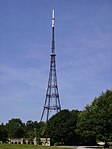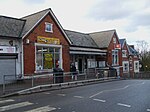The Crystal Palace was a cast iron and plate glass structure, originally built in Hyde Park, London, to house the Great Exhibition of 1851. The exhibition took place from 1 May to 15 October 1851, and more than 14,000 exhibitors from around the world gathered in its 990,000 square feet (92,000 m2) exhibition space to display examples of technology developed in the Industrial Revolution. Designed by Joseph Paxton, the Great Exhibition building was 1,851 feet (564 m) long, with an interior height of 128 feet (39 m), and was three times the size of St Paul's Cathedral.The introduction of the sheet glass method into Britain by Chance Brothers in 1832 made possible the production of large sheets of cheap but strong glass, and its use in the Crystal Palace created a structure with the greatest area of glass ever seen in a building. It astonished visitors with its clear walls and ceilings that did not require interior lights.
It has been suggested that the name of the building resulted from a piece penned by the playwright Douglas Jerrold, who in July 1850 wrote in the satirical magazine Punch about the forthcoming Great Exhibition, referring to a "palace of very crystal".After the exhibition, the Palace was relocated to an area of South London known as Penge Place which had been excised from Penge Common. It was rebuilt at the top of Penge Peak next to Sydenham Hill, an affluent suburb of large villas. It stood there from June 1854 until its destruction by fire in November 1936. The nearby residential area was renamed Crystal Palace after the landmark. This included the Crystal Palace Park that surrounds the site, home of the Crystal Palace National Sports Centre, which had previously been a football stadium that hosted the FA Cup Final between 1895 and 1914. Crystal Palace F.C. were founded at the site and played at the Cup Final venue in their early years. The park still contains Benjamin Waterhouse Hawkins's Crystal Palace Dinosaurs which date back to 1854.












